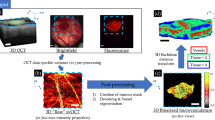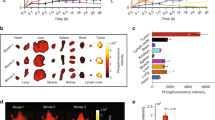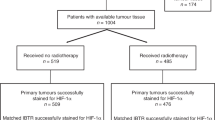Abstract
Hypoxia-induced radiation resistance has been proposed to be a consequence of low vascular density in tumours. The purpose of the study reported here was to investigate possible relationships between pretreatment oxygen tension (pO2) and vascular density in patients with cervix carcinoma. Tumour pO2 was measured by the use of polarographic needle electrodes. Biopsies were taken from the electrode tracks and vascular density and tissue composition, i.e. volume fraction of carcinoma tissue, stroma and necrosis, were determined by stereological analysis. The vascular density of individual biopsies was related to the median pO2 of the corresponding electrode track. Tumour regions with vascular density below 24 mm mm(-3) always showed low pO2, whereas tumour areas with vascular density above 24 mm mm(-3) could show a high or a low pO2. This indicates the existence of a threshold value of about 24 mm mm(-3) for vascular density in cervix carcinoma; a vascular density above this value is probably needed before high pO2 can occur. Low vascular density might, therefore, be a useful predictor of hypoxia-induced radiation resistance in cervix carcinoma. High vascular density, on the other hand, can probably not be used to exclude radiation resistance. The differences in pO2 among tumour regions with high vascular density were not a consequence of differences in the amount of necrosis or stroma or in the haemoglobin concentration in peripheral blood of the patients. Model calculations indicated that these differences in pO2 could be explained by differences in the oxygen delivery alone and by differences in the oxygen consumption rate alone.
This is a preview of subscription content, access via your institution
Access options
Subscribe to this journal
Receive 24 print issues and online access
$259.00 per year
only $10.79 per issue
Buy this article
- Purchase on Springer Link
- Instant access to full article PDF
Prices may be subject to local taxes which are calculated during checkout
Similar content being viewed by others
Author information
Authors and Affiliations
Rights and permissions
About this article
Cite this article
Lyng, H., Sundfør, K., Tropé, C. et al. Oxygen tension and vascular density in human cervix carcinoma. Br J Cancer 74, 1559–1563 (1996). https://doi.org/10.1038/bjc.1996.589
Issue Date:
DOI: https://doi.org/10.1038/bjc.1996.589
This article is cited by
-
Hypoxia in cervical cancer: from biology to imaging
Clinical and Translational Imaging (2017)
-
What is the malignant nature of human ductal carcinoma in situ?
Nature Reviews Cancer (2011)
-
Blood flow and oxygenation status of human tumors
Coloproctology (1999)
-
Blood flow and oxygenation status of human tumors
Strahlentherapie und Onkologie (1999)



